Cleanroom Cranes for Sterile Ingredient Handling 0.25 T to 2 Ton
Inmodern industry, few stages are as crucial as the cleanroom. These controlled environments, meticulously engineered to maintain exceptionally low levels of airborne particles and contaminants, serve as the nerve centers of sectors ranging from pharmaceuticals to electronics manufacturing. Within these pristine chambers, every component and process must adhere to stringent cleanliness standards, making the role of equipment within them paramount.
At the heart of cleanroom operations lie the humble yet indispensable cranes. While often overshadowed by more glamorous machinery, these stalwart workhorses form the backbone of sterile ingredient handling, ensuring the smooth flow of materials and equipment without compromising the meticulously maintained cleanliness of the environment.
As we delve into the realm of cleanroom cranes for sterile ingredient handling, let's explore their importance, functions, and applications in detail. Join us on a journey through the nexus of precision and hygiene, where every lift is a testament to the meticulous standards of modern industry.
Types of Cranes for Cleanrooms
Cleanroom cranes are specialized lifting devices designed to operate within controlled environments where cleanliness and sterility are paramount. Unlike conventional cranes, which may generate dust, particulates, or contaminants during operation, cleanroom cranes are meticulously engineered to minimize the risk of introducing impurities into the environment.
Key characteristics of cleanroom cranes include:
Construction from nonshedding materials: Cleanroom cranes are typically constructed from materials such as stainless steel or aluminum, which are resistant to corrosion and minimize the generation of particles.
Sealed components: Critical components of cleanroom cranes, such as motors and bearings, are often sealed to prevent the ingress or egress of contaminants.
Smooth surfaces: Surfaces of cleanroom cranes are designed to be smooth and free of crevices where particles could accumulate, simplifying cleaning and maintenance procedures.
Compatibility with cleanroom protocols: Cleanroom cranes are designed to integrate seamlessly with cleanroom protocols, including protocols for gowning, decontamination, and air filtration.
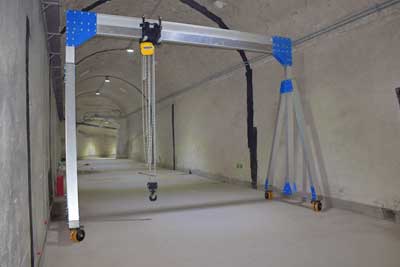
LT1: Aluminum Gantry Crane with Fixed Span and Height
- Capacity up to 5 tons.
- Span up to 4 meters.
- Max. height up to 5 meters
Get Fixed Span & Fixed Hight Aluminum Alloy Gantry Crane Price
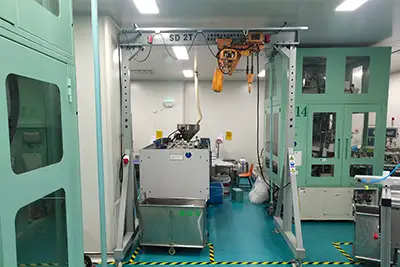
lT 2 Height Adjustable Aluminum Gantry Cranes
- Capacity up to 5 tons.
- Span up to 4 meters.
- Max. height up to 5 meters
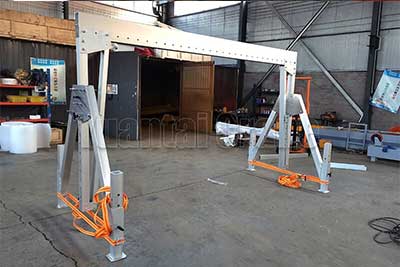
LT3: Fixed Aluminum Gantry Crane with Adjustable Span and Height
- Capacity up to 2 tons.
- Span up to 4 meters.
- Max. height up to 4 meters
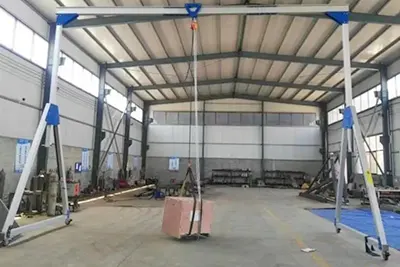
lT4 Simple Gantry Cranes with adjustable Height & Span
- Capacity up to 2 tons.
- Span up to 4 meters.
- Max. height up to 4 meters
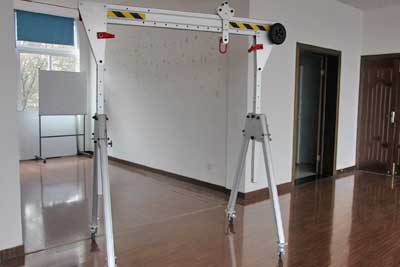
LT5:Foldable Aluminum Gantry Crane with Adjustable Span and Height
- Capacity up to 3 tons.
- Span up to 4 meters.
- Max. lifting height is no more than 6 meters
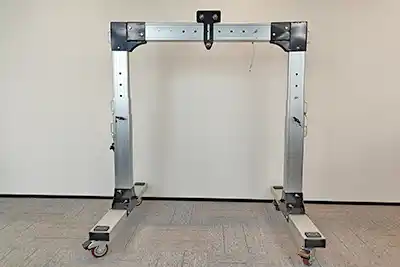
LT6 Ajustable Gantry Crane with Telescoping Height and Span T Frame Gantry Cranes
- Capacity up to 2 tons.
- Span up to 4 meters.
- Max. lifting height is no more than 4 meters
Variants: Overhead Bridge Cranes, Jib Cranes, Gantry Cranes
Overhead Bridge Cranes:
Overhead bridge cranes are one of the most common types of cleanroom cranes, characterized by their ability to span large distances and provide precise lifting and positioning capabilities.
They consist of a horizontal bridge supported by end trucks, which move along elevated runways installed within the cleanroom.
Overhead bridge cranes are ideal for applications requiring highcapacity lifting and precise material handling within cleanroom environments.
Jib Cranes:
Jib cranes are compact lifting devices characterized by their ability to rotate around a vertical axis, providing versatile lifting capabilities within a limited workspace.
They consist of a vertical mast mounted to a wall or column, with a horizontal boom extending from the mast to support the lifting mechanism.
Jib cranes are commonly used for localized lifting and material handling tasks within cleanroom environments, offering flexibility and ease of operation.
Gantry Cranes:
Gantry cranes are freestanding lifting devices characterized by their ability to straddle large work areas and provide mobility for lifting and positioning tasks.
They consist of a horizontal bridge supported by legs or uprights, which move along rails or tracks installed on the floor of the cleanroom.
Gantry cranes are suitable for applications requiring mobility and flexibility in lifting and material handling operations within cleanroom environments, offering a versatile solution for a wide range of tasks.
Typical Loads Handled by Cleanroom Cranes
Sterile Ingredients
Definition and Significance:
Sterile ingredients refer to substances or components that are free from viable microorganisms and contaminants, making them suitable for use in sterile manufacturing processes.
Maintaining the sterility of ingredients is critical in industries such as pharmaceuticals and biotechnology, where even minute contamination can compromise the safety and efficacy of the final product.
Examples:
Pharmaceuticals: Active pharmaceutical ingredients (APIs), excipients, and other raw materials used in drug formulation must be sterile to ensure the quality and safety of the finished pharmaceutical products.
Biotech Products: Cell culture media, growth factors, and recombinant proteins used in biotechnology applications must be sterile to support cell growth and maintain product purity.
Packaging Materials
Importance in Maintaining Cleanliness:
Packaging materials play a vital role in maintaining the cleanliness and integrity of products during storage, transportation, and distribution.
Contaminated packaging materials can introduce impurities or particles into sterile environments, compromising the quality and safety of the packaged products.
Examples:
Containers: Sterile vials, bottles, and bags are commonly used to package pharmaceuticals, biotech products, and other sterile materials, providing a protective barrier against contamination.
Wrappers: Sterile pouches, foils, and wraps are used to enclose sterile medical devices, surgical instruments, and other sensitive products, safeguarding them from environmental contaminants.
Machinery Parts
Essential Components for Cleanroom Equipment:
Machinery parts refer to components, assemblies, or subassemblies used in the construction, operation, and maintenance of cleanroom equipment and systems.
These parts must meet strict cleanliness and sterility requirements to prevent the introduction of contaminants into cleanroom environments.
Examples:
Pumps: Cleanroomcompatible pumps, such as peristaltic pumps and diaphragm pumps, are used for fluid transfer and circulation in pharmaceutical manufacturing, bioprocessing, and semiconductor fabrication.
Valves: Precision valves, including diaphragm valves and solenoid valves, are employed in cleanroom equipment for controlling the flow of liquids and gases with minimal risk of contamination.
Filters: Highefficiency particulate air (HEPA) filters and ultralow particulate air (ULPA) filters are essential components of cleanroom ventilation systems, removing airborne particles and microorganisms to maintain cleanliness and sterility.
Understanding the types of loads handled by cleanroom cranes is essential for optimizing their design, operation, and maintenance within sterile manufacturing environments. In the following section, we'll explore the diverse applications of cleanroom cranes in sterile ingredient handling operations.
Applications of Cleanroom Cranes
Cleanroom Environments
Need for Controlled Environments in Sensitive Industries:
Industries such as pharmaceuticals, biotechnology, semiconductor manufacturing, and aerospace rely on cleanroom environments to ensure the quality, safety, and reliability of their products.
Cleanrooms provide controlled environments with low levels of airborne particles, contaminants, and microorganisms, minimizing the risk of product defects and ensuring compliance with regulatory standards.
Requirements for Cleanliness and Sterility:
Cleanroom environments must adhere to strict cleanliness and sterility requirements, typically defined by international standards such as ISO 14644 and US Federal Standard 209E.
Cleanroom classifications, ranging from ISO Class 1 to ISO Class 9, specify the maximum allowable concentration of airborne particles per cubic meter of air, depending on the sensitivity of the manufacturing process.
Maintaining cleanliness and sterility within cleanrooms requires specialized equipment, including cleanroom cranes, designed to minimize contamination risks during material handling and processing operations.
Sterile Ingredient Transfer
Critical for Pharmaceutical and Biotech Production:
The transfer of sterile ingredients is a fundamental step in pharmaceutical and biotech production processes, where the integrity and purity of raw materials directly impact the quality and safety of the final products.
Cleanroom cranes play a crucial role in facilitating the safe and efficient transfer of sterile ingredients, ensuring that they remain free from contamination throughout the handling and processing stages.
Importance of Preventing Contamination:
Contamination of sterile ingredients can occur at various stages of handling, including storage, transportation, and transfer between processing equipment.
Cleanroom cranes are equipped with features such as sealed components, smooth surfaces, and nonshedding materials to minimize the risk of contamination and maintain the sterility of ingredients during lifting and positioning operations.
Packaging Operations
Handling of Sterile Packaging Materials:
Cleanroom cranes are used in packaging operations to handle sterile packaging materials, such as containers, wrappers, and pouches, used for enclosing pharmaceuticals, biotech products, and medical devices.
Precise and controlled handling of packaging materials is essential to prevent damage or contamination and ensure the integrity of the sterile barrier packaging.
Ensuring Product Integrity and Safety:
Packaging operations within cleanroom environments are critical for ensuring the integrity and safety of sterile products throughout their lifecycle, from manufacturing to distribution and use.
Cleanroom cranes provide the precision and reliability required to handle packaging materials with care, minimizing the risk of product defects or breaches in sterility.
By understanding the diverse applications of cleanroom cranes in sterile manufacturing environments, industries can optimize their cleanroom operations to meet the highest standards of cleanliness, sterility, and product quality. In the next section, we'll explore the typical capacity range of cleanroom cranes and considerations for selecting the appropriate crane for specific applications.
Typical Capacity Range of Cleanroom Cranes
The capacity range of a cleanroom crane refers to the maximum load weight that the crane is designed to lift and maneuver safely within the cleanroom environment. This range is crucial for selecting the appropriate crane for specific lifting tasks and ensuring compliance with safety standards and operational requirements.
Factors Influencing Capacity Selection
Several factors influence the selection of the capacity range for cleanroom cranes, including:
- Nature of Loads: The weight and dimensions of the loads to be handled determine the required capacity range of the crane. It's essential to consider both the maximum load weight and any potential variations in load sizes during operation.
- Frequency of Use: The frequency and intensity of lifting operations within the cleanroom impact the selection of the crane's capacity range. Highvolume production environments may require cranes with higher capacity ranges to accommodate frequent lifting tasks.
- Safety Regulations: Compliance with safety regulations and standards is paramount when selecting the capacity range of cleanroom cranes. The crane's capacity should exceed the maximum anticipated load weight to ensure safe and reliable operation without compromising personnel safety or equipment integrity.
- Future Expansion: Consideration should be given to potential future expansion or changes in production processes that may require the handling of heavier loads. Selecting a cleanroom crane with a capacity range that allows for scalability and adaptability can help mitigate the need for costly upgrades or replacements in the future.
Range: 0.25 to 2 Tons
Suitable for Most Cleanroom Applications:
The typical capacity range of cleanroom cranes, ranging from 0.25 to 2 tons, is wellsuited for a wide range of cleanroom applications across various industries.
This capacity range accommodates the lifting and maneuvering of common loads encountered in pharmaceutical, biotech, semiconductor, and other cleanroom environments, including sterile ingredients, packaging materials, and machinery parts.
Considerations for Heavier Loads:
While the 0.25 to 2ton capacity range is sufficient for many cleanroom applications, certain specialized tasks may require cranes with higher capacity ranges.
When handling heavier loads exceeding 2 tons, additional considerations must be made regarding crane design, structural integrity, and safety features to ensure reliable performance and compliance with cleanroom requirements.
Customized solutions, such as heavyduty cleanroom cranes or gantry systems, may be required for lifting operations involving exceptionally heavy or bulky loads.
By understanding the typical capacity range of cleanroom cranes and the factors influencing capacity selection, industries can make informed decisions when choosing the appropriate crane for their cleanroom operations. Selecting the right crane ensures efficient material handling, enhances productivity, and maintains the integrity of the cleanroom environment.
Conclusion
Throughout this exploration of cleanroom cranes for sterile ingredient handling, it becomes evident that these specialized lifting devices play a pivotal role in maintaining the integrity of cleanroom environments. Cleanroom cranes are not mere tools for material handling; they are essential components of the intricate ecosystem of sterile manufacturing processes. From transferring sterile ingredients to handling packaging materials with precision, cleanroom cranes ensure that every lift is executed with utmost care and adherence to cleanliness standards.
The importance of cleanroom cranes extends far beyond the realm of lifting equipment. They serve as guardians of cleanliness and sterility, safeguarding the purity and safety of pharmaceuticals, biotech products, and other sensitive materials. By minimizing the risk of contamination and maintaining stringent cleanliness standards, cleanroom cranes contribute to the efficiency and reliability of cleanroom operations. Their precision, reliability, and compatibility with cleanroom protocols make them indispensable assets in industries where quality and safety are paramount.
As technology advances and industries evolve, the landscape of cleanroom crane technology is poised for further innovation and development. Future advancements may focus on enhancing the efficiency, safety, and automation capabilities of cleanroom cranes, allowing for seamless integration with advanced manufacturing processes and Industry 0 initiatives. These developments may include:
- Smart Crane Systems: Integration of sensors, actuators, and IoT (Internet of Things) technologies to enable realtime monitoring, predictive maintenance, and datadriven optimization of cleanroom crane operations.
- Automation and Robotics: Incorporation of robotic systems and automated material handling solutions to streamline cleanroom operations, reduce manual intervention, and improve productivity.
- Enhanced Cleanroom Compatibility: Continued research and development of materials, coatings, and design features to further enhance the cleanliness, sterility, and compatibility of cleanroom cranes with stringent cleanroom requirements.
- Safety and Ergonomics: Focus on ergonomic design principles and safety features to ensure the wellbeing of cleanroom crane operators and personnel, minimizing the risk of workplace injuries and improving overall efficiency.
In conclusion, cleanroom cranes represent a fusion of precision engineering, cleanliness, and sterility, essential for the success of industries reliant on controlled environments. As technology advances, cleanroom crane technology will continue to evolve, offering new possibilities for enhancing efficiency, safety, and reliability in sterile manufacturing operations. By embracing these advancements and leveraging the capabilities of cleanroom cranes, industries can continue to push the boundaries of innovation while upholding the highest standards of quality and integrity.




